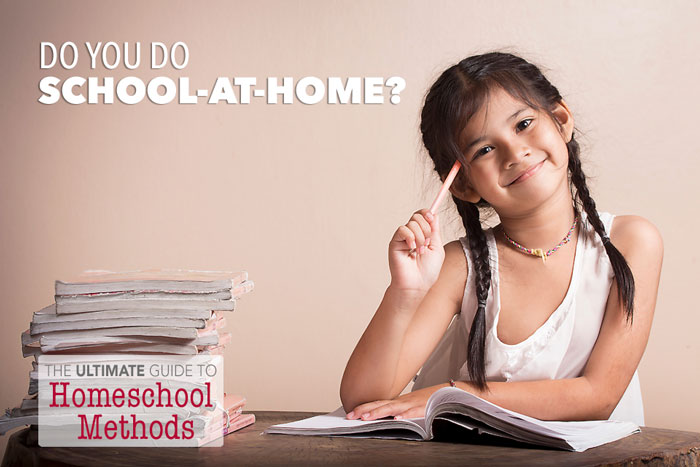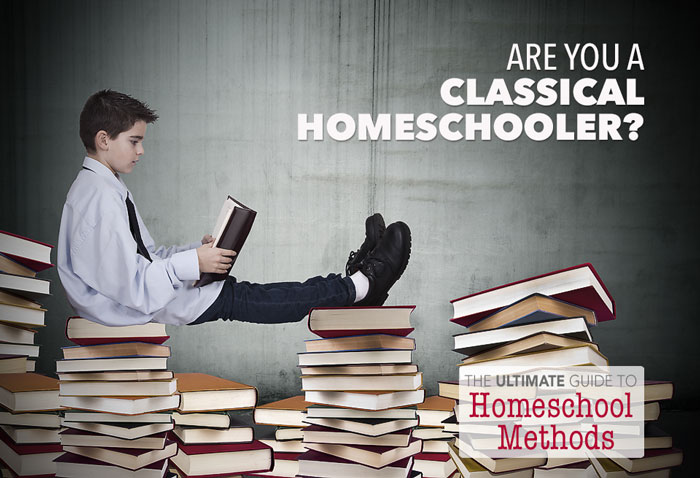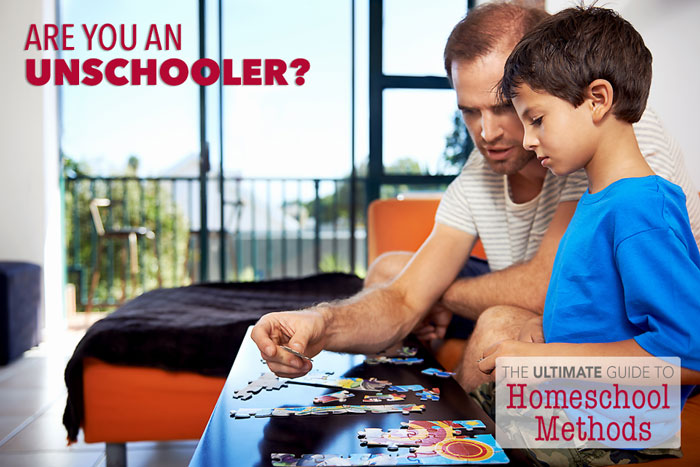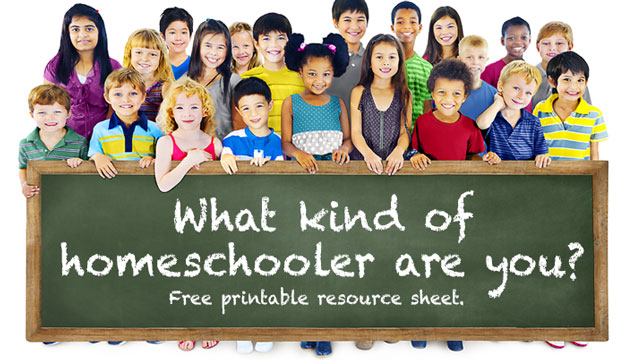
Knowing you are going to homeschool from the time your child is an infant and being an information junkie is a bit of a recipe for homeschool information overload.
Unwilling to drill my ten-month-old on her ABCs — I was at least that intelligent — I threw myself into the heady business of researching the vast array of homeschool materials out there. That array is indeed VAST, and can we say, overwhelming?
Add to that, when I started my research on homeschooling, I fully anticipated recreating at home the same education I taught to my students in school — the same education using the same methods I had received myself as a public school student.
Instead, I was amazed to discover there are actually multiple educational philosophies and methods. They never mentioned those at all in teacher college. Ahem.
So what we have here is the good — you as a homeschooling mom have a number of different choices of philosophies and methods to use in educating your kids. We also have the bad — there is a huge amount of information out there to wade through before you can make an intelligent decision about which method to use.
My job here is to narrow down the information for you, objectively (I hope) present the pros and cons of each method and then provide you with additional resources you can use for more information on methods you would like to study in-depth.
Do I have a favorite method? One you use and love above all the others? I do. My hope is you can’t determine what it is by reading just this post. 🙂
I will also say, I have experimented with every method on this list before I chose the path that my family is now on. While I am not an expert in following any of these methods, I do consider myself an expert in researching them.
It is with that expertise I take you by the hand and guide you through the vast array. Enjoy.
1. Unit studies
Listen to an audio interview with Heather Woodie all about her Unit Study family.
Hallmarks of the method
All students in a family are taught together using a unifying theme. That theme may be topical like the moon, the Civil War, or a specific virtue like attentiveness.
When children are close in age, unit studies might be built around a single book or piece of literature like Little House on the Prairie or The Very Hungry Caterpillar.
Families may complete one long unit study each year or multiple smaller ones.
Typically, all subjects except math are taught through the unit study activities. You can see an example in this unit based on the book Sarah, Plain, and Tall. The subjects covered are reading skills, vocabulary, English skills, science, music, poetry, arts and crafts, history, geography, and Bible. This unit study also includes a detailed math section.
Touted benefits
The entire family learns subjects together, making planning and the daily schedule easier for mom.
Units are often chosen based on student interests and therefore more likely to spark a love of learning.
Subjects are integrated mimicking real-life situations and problem-solving. Life is approached as a whole instead of by isolated subjects.
Misunderstandings and arguments against
Susan Wise Bauer argues in this blog post that sometimes unit study families do not differentiate between skill and content subjects in a unit study. She contends that children “need organized, systematic grammar, spelling, and writing programs so that these important skills can become easy,” and a fragmented teaching approach to these subjects will lead to gaps in the skill areas.
She also argues that subjects like math and science have their own internal logic and should be studied separately. The post is a very balanced view of unit studies and worth a look.
Charlotte Mason educators argue that unit studies make connections for the student and get in the way of the student making his or her own connections.
Books and curricula
- Five in a Row: Volume 1
- Unit Studies Made Easy
- Konos Character Curriculum – Volume 1 with Lesson Plans (Volume 1)
- Units Studies from Homeschoolshare.com
Websites and blogs
- Unit Studies Page on The Homeschool Mom
- Five in a Row
- Cathy Duffy’s Unit Study Index
- Homeschool Share Blog
- Blog She Wrote
- SusanEvans.org
2. Charlotte Mason
Listen to an interview with Brandy Vencel that is all about her Charlotte Mason family.
Hallmarks of the method
The Charlotte Mason method is named after its founder who lived in England from 1842-1923. Mason was a forward-thinking educator who believed all children, regardless of rank or economic status, deserved and were capable of a broad liberal arts education.
She started a teacher training college and parent’s union to train school teachers, governesses, and parents in her philosophy and methods. She also outlined the principles, which evolved over the course of her lifetime, in her six-volume set of books on education. It is recommended those new to Charlotte Mason begin with Volume 6 of her works.
The method is based on Mason’s 20 Principles. A thorough understanding of these principles is necessary to understanding the entirety of Mason’s philosophy.
Simply following a set curriculum or book list will not ensure a Charlotte Mason education without a grounding in these principles and her six volumes.
This book-rich education centers upon the selection of high-quality, worthy (living) books, reading small portions of the book at a time, then having the children narrate what was read.
Students under grade four do all of their narrations orally, while written narrations are introduced and phased in for all subjects at grades four and above.
Mason focuses heavily on the training of habits. In fact, training good habits in children — such as attention, obedience, diligence, and more — make up a full one-third of a child’s education. (The “Education is a discipline” portion of Mason’s parent motto.)
Other common practices within the Charlotte Mason method include spending a large amount of time outside, nature journaling, composer study, and picture study. The goal of a Charlotte Mason education is to spread a wide feast of the liberal arts before the student.
Touted benefits
Narration is a higher form of synthesis of information than simply answering a set of predetermined questions. Children’s skills in listening, attention, speaking, and writing are all strengthened through narration.
Students build good education and personal habits that are then use throughout life to continue their own education.
Students are exposed to a feast of ideas instead of dry facts.
Misunderstandings and arguments against
The Charlotte Mason method is sometimes perceived as a relaxed, child-led, or gentle form of homeschooling. Method purists feel this misunderstanding stems from people reading about the method from a second party instead of going straight to the source — Charlotte Mason’s six volumes.
Some homeschoolers feel that to faithfully follow Charlotte Mason you must read the same books she read in her own schools, all of which are over 100 years old. Others argue Mason was constantly tweaking her own book selections from year-to-year and would have continued to consider modern books (of value) if she were alive today.
Books and curricula
- Towards a Philosophy of Education: Charlotte Mason Volume VI
- Start Here: A Journey Through Charlotte Mason’s 20 Principles
- For the Children’s Sake
- Consider This
Websites and blogs
- Simply Charlotte Mason
- Ambleside Online
- Afterthoughts
- Joyous Lessons
- Charlotte Mason in Community
- Crossing the Brandywine
3. School-at-home (school-in-a-box)
Listen to an interview with Margaret Berns all about her school-at-home family.
Hallmarks of the method
School-at-home looks just like the public school methods many of us were raised with. There are textbooks for each subject, often all from one publisher, and students sit and work through assignments in each book until the book is complete. Sometimes DVD or computer instruction are used to supplement or replace texts.
School-at-home is often employed by families who do not have a problem with the methods of instruction in public schools — only the content or the environment.
Touted benefits
It is easiest to do what you know. For many parents, simply replicating school in the home or using a complete boxed curriculum adds a layer of ease to homeschooling that makes it doable.
Traditional coursework makes creating a traditional transcript (and subsequently college admissions) a simpler process.
Misunderstandings and arguments against
Many parents remember school and textbook learning as drudgery or remember their school experience as memorize, regurgitate, and forget. They want to offer what they feel is a more effective alternative for their children.
Books and curricula
Websites and blogs
4. Classical
Listen to an interview with Jennifer Dow about her Classical Education family.
Hallmarks of the method
There are currently two types of education currently labeled classical: neoclassical and the liberal arts tradition. While both are strong on language and seek to go back to a more historically-based curriculum, the approaches emphasize different aspects.
Neoclassical education focuses on the three stages of the trivium as outlined by Dorothy Sayers in The Lost Tools of Learning. The grammar, or youngest stage, focuses on learning knowledge through memorization and skills through practice. The dialectic, about middle school, stage focuses on learning to reason through logic and questioning. Finally, the rhetoric stage, about high school, focuses on applying the knowledge and logic from the previous two stages to write and speak with ability and authority.
The classical liberal arts tradition differs slightly from the neoclassical in that the focus is on seeking the True, Good, and Beautiful through a study of good and great books, effective communication through speaking and writing, Latin, and formation of the moral imagination through story and myth.
Touted benefits
The aim of classical education is not to create a worker for a specific job, but instead a virtuous person who seeks to continue learning throughout his or her life.
The focus on skills of communication — strong reading, writing, and speaking — make classically educated students well-rounded learners defined by their abilities instead of their job skills. The classically educated student has learned to learn and is able to adapt to change and obtain new skills easily.
The ability to reason and craft an eloquent argument aids all areas of life from personal to public.
Misunderstandings and arguments against
Some parents feel that a focus on rote memorization is akin to boring “drill and kill” and counter to critical thinking.
Critics argue that the Euro-centric focus of classical education is elitist and excludes non-Western cultures.
Classical education is seen as too rigorous by some, while others feel it downplays science and mathematics and the current trend towards an emphasis on STEM classes.
Books and curricula
- An Introduction to Classical Education
- The Core
- A Guide to Teaching Classically
- The Liberal Arts Tradition
- The Well-Trained Mind
Websites and blogs
5. Unschooling
Listen to an interview with Sue Elvis about her unschooling family.
Hallmarks of the method
All learning is child-centered and child-chosen. Students choose which topics they would like to study and the method they use to study them.
There is no formal curriculum. If a student does not wish to study math and would instead like to spend all of their time reading Little House books, watching TV, or studying painting with watercolors – that is OK.
Touted benefits
Because students choose their own course of study they are interested in what they are learning and therefore will retain the information.
Students are respected as persons and not forced or coerced to learn against their will.
Misunderstandings and arguments against
Arguments include that students will be ill-prepared for higher education or the workplace because they have not learned the necessary skills if they have not chosen to learn them.
The lack of a consistent curriculum can cause huge gaps in knowledge and learning.
Unschooling is often associated with unparenting.
Books and curricula
- Teach Your Own: The John Holt Book of Homeschooling
- A Little Way of Homeschooling
- Moving a Puddle
- Free to Learn: Why Unleashing the Instinct to Play Will Make Our Children Happier, More Self-Reliant, and Better Students for Life
Websites and Blogs
- Sue Elvis Writes
- These Temporary Tents
- I’m Unschooled. Yes, I Can Write
- Unschooling.org
- Journey Into Unschooling (invite-only blog)
Yes, I realize that there are other educational methods, many of which — literature based, eclectic, etc. — are a hybrid of the above. Montessori has also seen some growth in homeschooling circles.
So if I left out your favorite type of homeschooling, feel free to introduce us to it in the comments below and leave a link to your blog or your favorite blog for that method.
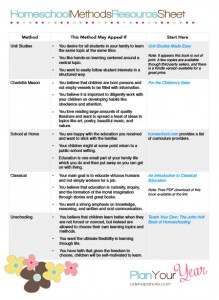
We will talk about implementing the methods, the strengths of each method, and what a typical day looks like in their home.
As a gift to you, I am offering this free downloadable reference sheet on homeschooling methods. Find out which method might appeal to you, and the number one resource I recommend for beginning to explore each method. Enter your info to get your reference guide.
- How to Transform Math Lessons without Changing your Curriculum with Denise Gaskins - April 26, 2024
- Homeschooling Boys with Durenda Wilson - April 12, 2024
- What About Lab Sciences? with Dr. Moon - March 29, 2024




